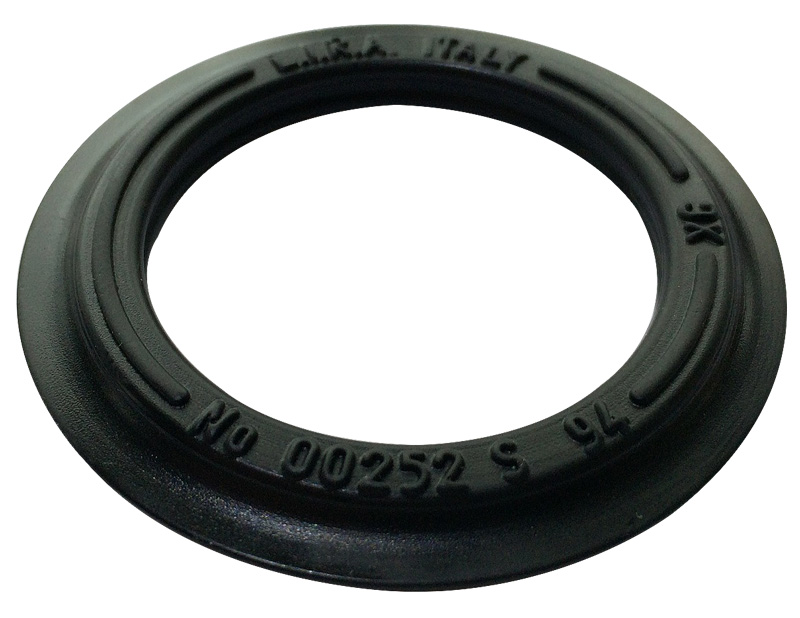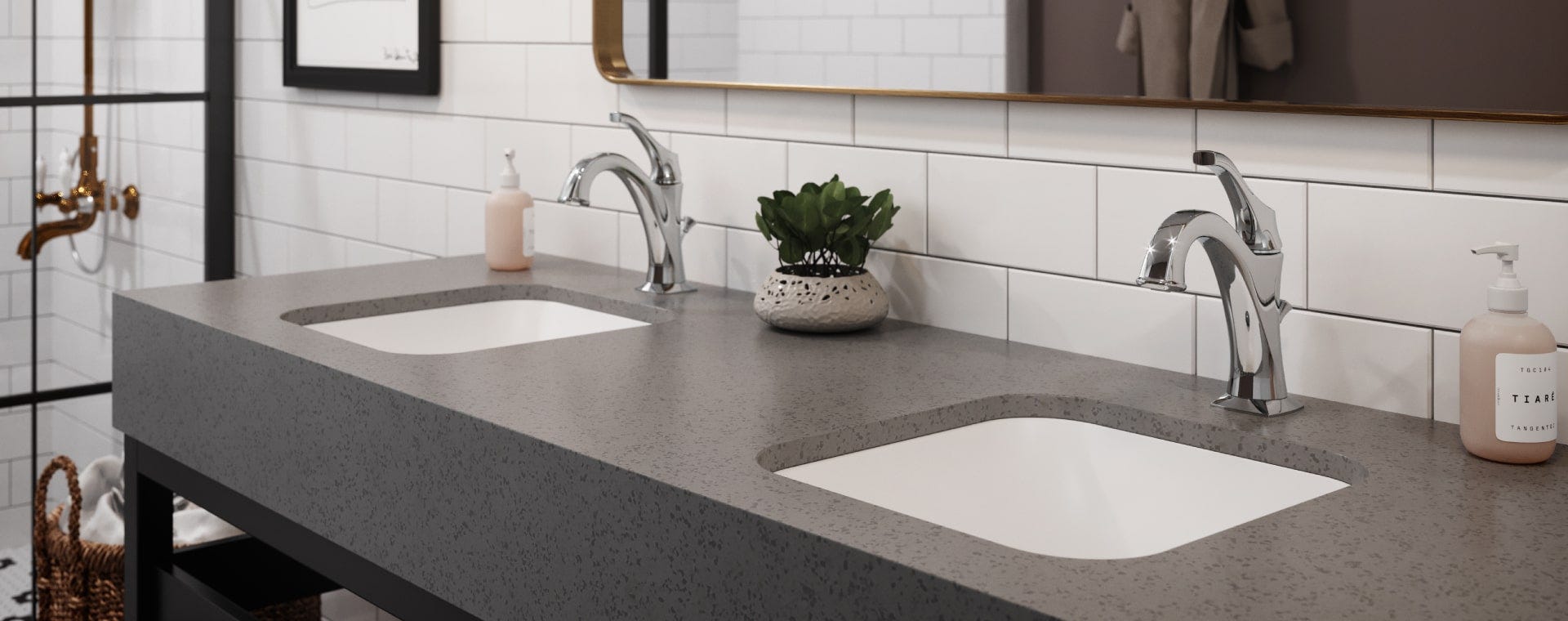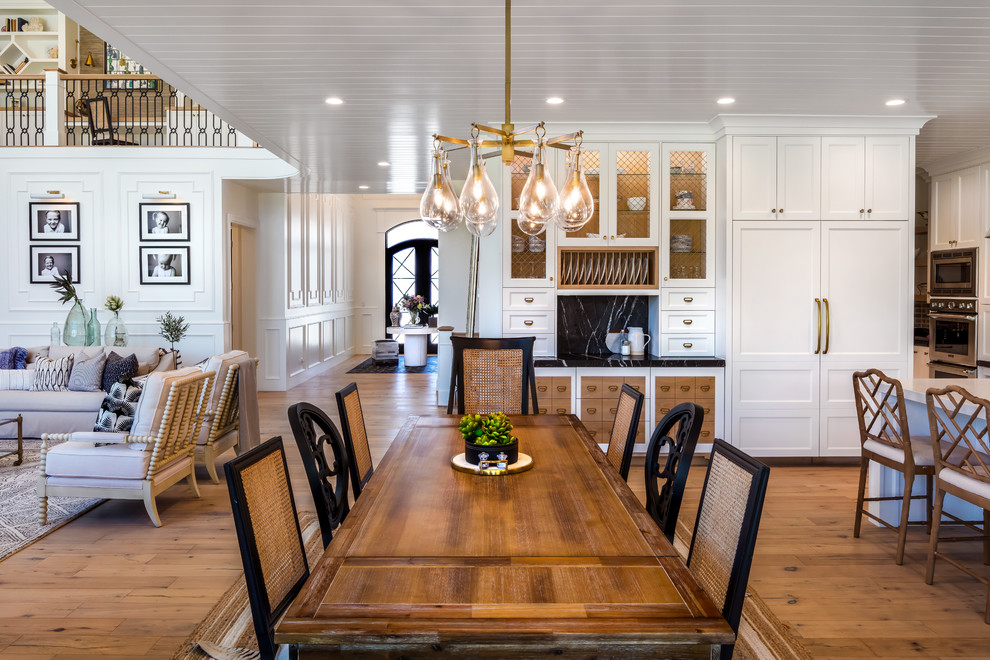One of the most common kitchen design regrets is not planning enough space for meal preparation and cooking. Despite homeowners hoping for large kitchens, most small spaces have limited countertop areas, leaving little room for multiple cooks in the kitchen. Even larger kitchens can be challenging to navigate due to lack of counter space. And if you're short on room, it's likely you'll opt for a kitchen island to maximize your counter top space, but this can create bottlenecks and inefficiency in the kitchen. When planning your kitchen design, make sure to consider adding more countertop space with an extra counter, an island, or both. And if you're considering a kitchen island, make sure you have enough room to actually use it without feeling cramped. When you plan kitchen designs, it's also important to keep in mind that not all countertop surfaces are created equal, especially when it comes to food prep. Natural stone, for example, can be porous and absorb bacteria and moisture. And if you're short on countertop space, you may regret making this mistake down the line, so it's important to choose the right materials for your kitchen. Another common mistake with kitchen design regrets is not having enough storage in the kitchen. Without adequate kitchen cabinets, you’ll find yourself short on space for storing all the necessities of cooking and keeping your kitchen organized. Not only does this cause clutter in the kitchen, but it can also create a stressful environment whilemeal preparation. To avoid this mistake, plan your kitchen design with enough room for cabinets, drawers, and any additional storage you’d like to add. Assess what items you need regular access to, such as dishes, spices, and utensils, and then plan adequate space for all of these items. You can also consider installing shelves or racks within your kitchen to provide additional storage without cluttering the room. Added storage options such as roll-out drawers and hanging pot racks can also be helpful in keeping everything in its place within your kitchen.Not Having Enough Prep Space
Not Paying Attention to Storage
When you're in the kitchen, you're likely using a number of small appliances to help with food preparation. From food processors and blenders to toasters and mixers, chances are you have a multitude of kitchen gadgets that require outlets to work. Going into a kitchen design regretting not having enough electrical outlets can cause serious kitchen headaches in the future. To avoid this kind of regret down the line, plan for your appliance needs when you're first designing your kitchen. Outlets should be placed in convenient spots throughout the kitchen so you won't have to unplug and replicate small appliances in order to use them. Additionally, you should also make sure that your electrical outlets can accommodate the voltage of all the appliances you plan on using in the kitchen. By planning ahead, you can make sure that your kitchen is outfitted with all the outlets and electricity you need to make cooking and baking easier.Too Few Electrical Outlets
Having energy efficient appliances and durable materials in the kitchen can have a large impact on your kitchen design regrets. Not only does energy efficiency help to save money on your energy bills, but it also reduces your environmental footprint. If you're remodeling your kitchen and not investing in energy efficient appliances and materials, then you may be facing energy regret in the future. When you plan your kitchen design, make sure to factor in the energy efficiency of all the appliances and materials you plan on using. Invest in energy star-rated or high efficiency appliances, as these are designed to use less energy than other models. Additionally, use durable materials that will last longer and don't require a lot of upkeep and energy to maintain. Poor Energy Efficiency
One of the most important aspects of kitchen design is the quality of the materials and appliances used. If you're looking to cut costs, you may find yourself purchasing lower quality items that can cost you in the long run. Your appliances are one of the most used items in your kitchen, which makes it important to invest in high-quality pieces from day one. Cheap or poorly made appliances will have a shorter life, leaving you with kitchen design regret when you find yourself replacing them down the line. When shopping for kitchen appliances, seek out well-known, high-quality brands that come with warranties. If possible, look for energy star-rated appliances that won't only last longer and work better, but that will help you save money on your energy bills. And if you're considering a more expensive appliance, Make sure to read reviews and assess the item for durability before you purchase.Buying Poor Quality Appliances
How you choose to use color in the design of your kitchen can play a key role in whether or not you experience kitchen design regrets down the line. Too much color can be overwhelming or distracting, while too little color can leave your kitchen feeling dull and mundane. Finding the right balance between the two is essential when planning your kitchen design. To stay away from design regrets, pick a few accent colors to bring life to the room. Consider incorporating colors through paintings, wall hangings, or kitchen accessories to help brighten the space. Additionally, it's important to use the right color palette, as the wrong colors can make the room look dull or disorganized. Bold colors such as red, yellow, and orange can be great for energizing the room, while softer shades of blue and green can create a calming effect. Misusing Color
While planning your kitchen design, it's important to think about the primary function of the room. How you plan to use the kitchen can dictate what type of materials or fixtures you need to add, and to what degree you need to plan for durability or accessibility. Not knowing the primary purpose of your kitchen can lead to design regrets and challenges down the line. Think about how often you use the kitchen, and what objects, appliances, and materials you'll need for daily use. Low-grade materials or appliances may be cheaper in the short term, but they may not last for frequent use, leading to more cost down the line. If you're building a kitchen for high-traffic or regular use, you'll likely need heavier duty materials and appliances to last throughout the years. Additionally, if you plan on hosting large groups or holding weekly cooking classes, you may need to consider extra counter space and storage, ensuring that everyone is able to use the kitchen comfortably.Not Knowing the Function of the Room
When you’re designing your kitchen, it’s important to choose the right countertop materials to ensure you don’t face design regrets down the line. Many homeowners choose granite as a countertop material, as it’s a durable and beautiful-looking stone, but it also comes with unique cleaning and maintenance requirements. It’s also important to note that granite isn’t the only countertop material you can use in your kitchen. If you’re looking for a low-maintenance option in the kitchen, consider using quartz. The surface is non-porous and resists staining and scratches, making it an ideal material for kitchen countertops. Marble, on the other hand, is a softer material and may require more frequent cleaning and maintenance compared to quartz. Additionally, it’s important to note that both marble and granite are very expensive, and may not be in your budget.Choosing the Wrong Countertop Material
Before you start designing the layout of your kitchen, it’s important to think carefully about how you plan to use the space. If you’re opening up a new kitchen, for example, you’ll need to consider where any appliances or fixtures will fit, and how far apart everything needs to be spaced for ease of use. Not knowing the layout of your kitchen can lead to design regrets down the line, as well as safety risks. When drawing out the layout of your kitchen, make sure to account for any walls or countertops that may be in the way. Additionally, it’s important to keep stovetops, ovens, and other appliances far away from high-traffic areas, as these surfaces can get very hot. Lastly, make sure to account for your desired kitchen accessories such as cabinets, dish racks, and pot holders, and choose a layout that gives you easy access to everything without sacrificing on your counter space.Not Knowing the Layout of the Kitchen
When designing your kitchen, it’s important to keep in mind the primary use of the room. Whether you’re a frequent baker, entertainer, or everyday home chef, the type of appliances and materials you need will be directly impacted by the primary use of the room. If you’re planning to do a lot of baking, for example, you might need larger counter spaces and extra storage for all your baking equipment. Additionally, you might need to invest in higher-end appliances such as a mixer, convection oven, or food processor. If you plan on entertaining frequently, you might need more countertop space as well as double sinks for entertaining guests. Think about what your kitchen will be used for, and invest in items that will help your kitchen meet all these needs.Not Considering the Primary Use of the Kitchen
What are the Most Common Kitchen Design Regrets?
 For many homeowners, their kitchen has become the center of their home. It's where family and friends gather for meals, and it's become the most-used room in the house. But all too often, homeowners make design mistakes that they live with for years, leading to kitchen design regrets. Below, we explore some of the most common kitchen design regrets and how homeowners can avoid them.
For many homeowners, their kitchen has become the center of their home. It's where family and friends gather for meals, and it's become the most-used room in the house. But all too often, homeowners make design mistakes that they live with for years, leading to kitchen design regrets. Below, we explore some of the most common kitchen design regrets and how homeowners can avoid them.
Not Installing Enough Storage Space
 One of the most common
kitchen design regrets
is not having enough storage space. Open shelving and cupboards are often inadequate to store all of the items needed to keep a kitchen running smoothly. Homeowners should plan ahead for all the items they'll need to store and make sure they have the necessary cupboards and storage nooks to make their kitchen not only functional but organized.
One of the most common
kitchen design regrets
is not having enough storage space. Open shelving and cupboards are often inadequate to store all of the items needed to keep a kitchen running smoothly. Homeowners should plan ahead for all the items they'll need to store and make sure they have the necessary cupboards and storage nooks to make their kitchen not only functional but organized.
Skipping on the Quality Materials
 When renovating, it's easy to find yourself downgrading on the quality of materials used in the kitchen. Cheap countertops and flooring can break down much sooner than higher quality materials, leading to costly replacements. Homeowners should strive to use materials that will last and stand up to the wear and tear of an active kitchen.
When renovating, it's easy to find yourself downgrading on the quality of materials used in the kitchen. Cheap countertops and flooring can break down much sooner than higher quality materials, leading to costly replacements. Homeowners should strive to use materials that will last and stand up to the wear and tear of an active kitchen.
Choosing Uncomfortable Countertop Height
 Another common kitchen design regret is having countertops that are either too low or too high. Countertops that are either too low or too high can be extremely uncomfortable and make working in a kitchen much harder than it should be. Before installing a new countertop, it's important to take measurements and make sure it's at the right height for the user.
Another common kitchen design regret is having countertops that are either too low or too high. Countertops that are either too low or too high can be extremely uncomfortable and make working in a kitchen much harder than it should be. Before installing a new countertop, it's important to take measurements and make sure it's at the right height for the user.
Unfocused Lighting
 Homeowners can also find themselves tied down to an unfocused lighting plan. Overhead fixtures can create an ugly glare, and low light can make it difficult to work in the kitchen. Strategically placing several focused light sources can create a beautiful look while still providing ample light to work.
Homeowners can also find themselves tied down to an unfocused lighting plan. Overhead fixtures can create an ugly glare, and low light can make it difficult to work in the kitchen. Strategically placing several focused light sources can create a beautiful look while still providing ample light to work.
Inadequate Ventilation
 Finally, inadequate ventilation in a kitchen can become a major issue. Without a hood vent, smoke and steam quickly fill up the kitchen, making it difficult to work. A hood vent with the right CFM rating can quickly remove any extra heat or smoke and keep the kitchen comfortable.
As one of the most important rooms in any home, it's important to get your kitchen design right the first time. Taking the time to plan ahead and understand your wants and needs can help you avoid common kitchen design regrets.
Finally, inadequate ventilation in a kitchen can become a major issue. Without a hood vent, smoke and steam quickly fill up the kitchen, making it difficult to work. A hood vent with the right CFM rating can quickly remove any extra heat or smoke and keep the kitchen comfortable.
As one of the most important rooms in any home, it's important to get your kitchen design right the first time. Taking the time to plan ahead and understand your wants and needs can help you avoid common kitchen design regrets.


























































































